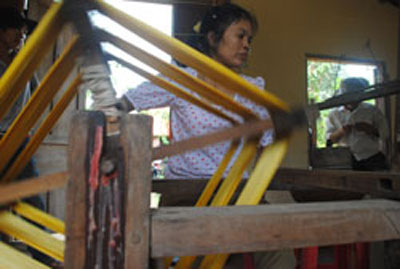
|
| Looming changes: A woman reels silk yarn at Hoi An-based Silk Village. The central province of Quang Nam is seeking to revive the traditional silk craft from the 17th century. (Photo: VNS) |
At the event, cultural researchers discussed the establishment and prosperous development of the traditional trade in the 17th century, and the influence of the Cham culture.
Participants also expressed their opinions on boosting the trade and sustainable development of the craft as part of the tourism industry.
"The silk trade started in the development of the Nguyen Dynasty to the south. The craft in Quang Nam was influenced by the Cham people in the coastal central region," famous Vietnamese writer Nguyen Ngoc told the seminar.
"If we want to restore the trade, we have to find out how mulberry and silkworm were raised by the Cham people in the past. Trailing the origin of the trade will help create a unique silk industry that once prospered in the past."
"Hoi An has been recognised by UNESCO as a world heritage site. People remember the city with a full-moon night and the twinkling of lanterns, so the silk trade has to be restored like the lantern crafts have been so far."
Le Thai Vu, general director of the Quang Nam Silk Company, successfully discovered the mulberry plant the Cham used during an expedition in Que Son District last year, after Japanese cultural researchers had failed in their efforts to find the plant.
"It's a significant find as it will help to revive the trade in Quang Nam. The 40-year-old plant was identified by scientists as the Cham mulberry. I strive to collect the silkworm of the Cham people and revive the trade that withered away in the early 1990s," Vu explained.
"The discovery of mulberry and silkworm will help produce the best quality silk that was well-known in the 17th century. However, the trade needs a change in design to lure customers and compete against silks from China, Japan, Thailand, and the others in Viet Nam."
The Quang Nam-born expert now cultivates mulberry in a garden for the future development of the trade.
He has also collected 40 kinds of mulberry which help silkworm produce the best quality of silk.
At the seminar, Vu's company also launched the Silk Village on Nguyen Tat Thanh Street.
The village, which covers on an area of 2ha, will act as a museum of silk trade and different kinds of mulberry.
"The village will help introduce the charming trade of the central province to the world. It will play as a destination for tourists who want to find out about the production of silk. They can witness how the people raise silkworms, and weave," said Tran Thi Chi Mai from the village.
Ho Viet Ly, director of the HCM City-based Toan Thinh Silk Company, said he was aware of the beauty of silk from Quang Nam.
"Quang Nam has been known for its silk over the past centuries. Yellow cocoon is a feature that makes silk from Quang Nam stand out from Van Phuc Village in Ha Noi and Bao Loc District in the Central Highlands province of Lam Dong," Ly said at the seminar.
"However, Quang Nam-made silk needs a special design that promotes the image of Hoi An – the heart of Quang Nam Province."
General director of Bao Loc Silk Company, Nguyen Trung Hieu said he saw little silk from Quang Nam on sale at a boutique in Hoi An.
"The silk trade in the province has to change its production methods. It needs to update with advanced weaving technology and farming of mulberry," said Hieu.
Vice chairman of the Hoi An People's committee Truong Van Bay said the administration would look at ways to boost the to develop the tourism industry.
Quang Nam Province has welcomed 900,000 tourists since the start of this year.
It has targeted to attract 1.7 million tourists this year.
VietNamNet/Viet Nam News